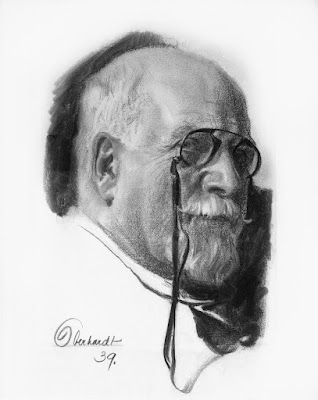William Oberhardt (American, 1882-1958) was known for his charcoal portraits, always drawn from life, always of men.
How did he achieve such convincing likenesses, where the subject seems animated and on the verge of speech?
The answer is that he engaged his subjects in a spirited conversation. He wanted to make sure that the sitter had a delightful experience, and he tried to bring out their best in the conversation.
Most of his drawings were achieved within an hour. After laying out the overall gesture he would focus on completing the eyes early in the process, because he knew he needed to get them right or the whole effort would be futile and he would have to start over.
Sidney Dickinson by William Oberhardt
To convey an individual likeness, he focused on the unique attributes of the person's face. He preferred to portray celebrities because "they are free from the inhibitions that the average man is heir to. The celebrity usually realizes that lines, plans, and wrinkles cannot be removed without loss of individuality, the individuality that has made him prominent...The trouble is that some people don't like their own faces. When that happens, I admit, the cards are stacked against you. No matter how much of the milk of human kindness you mix with your pictorial effort, you're fighting a losing game because a portraitist cannot redesign a face and still preserve a likeness."
The new issue of Illustration Magazine has a 23 page article with dozens of examples of Oberhardt's portraits, both in charcoal and oil, together with many notes about his process, including extended excerpts from several articles by Oberhardt himself.










4 comments:
You have such great articles, thank you James.
This issue of Illustration magazine came in on Saturday, the first of my new subscription thanks in large part to how often you speak of it on this blog.
While I enjoyed the magazine, I found the tops of the magazine pages were still perforated and hadn't been separated properly. I had to break the perforations to be able to open the magazine which creates a rough top edge. Has this happened to anyone else? I intend to reach out to the publisher and complain but am hoping that this was just my issue and not experienced by others.
Thanks,
Pierre
Pierre, I haven't heard of that happening before. I guess it's something that happened at the printer/binder. Having pages joined with a fold at the top used to be a common feature of early books, and the first reader had to carefully cut open the pages with a sharp knife.
Hey, great job. I read a lot of blog posts and I never heard of a topic like this. I love this topic you made about the blogger’s bucket list. Very ingenious. This Blog is interesting and please check out for more details, you can Click here,
Visit here
Post a Comment